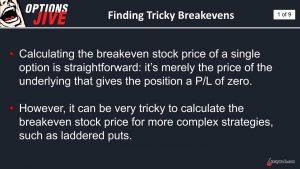Calculating the Breakevens of Options Trades
When considering new options trades, market participants often calculate associated breakevens for use in scenario analysis—an integral component of the broader risk management process.

When considering a new position in the market, most investors and traders conduct a scenario analysis.
This might be as simple as envisioning what might happen to a given position if the market corrects by 10%. Or, it might be as complex as envisioning what might happen to a given position if a stock goes bankrupt, or is taken out for a huge premium.
In either case, this process falls under the “risk management” umbrella.
The point of a scenario analysis is to consider a variety of potential scenarios and ensure that one is comfortable with those outcomes—taking into account the associated probability of each scenario, and the risk/reward associated with each scenario.
Looking at a hypothetical example, imagine a trader purchases 100 shares of Apple (AAPL) stock. At current market prices, it would cost $14,871.00 to enter the position ($148.71/share x 100 shares = $14,871.00).
Prior to entering this position, a trader or investor might consider the best-case and worst-case scenarios.
For example, imagine Apple reported surprisingly positive earnings, and the stock rallied by 20%. In that case, Apple stock would rally to $178.45, and the position would produce roughly $3,000 in profit.
Alternatively, imagine that the world ran short of the necessary materials to produce Apple products, and sales for the company were expected to crater. Under that scenario, Apple stock would likely correct in sharp fashion.
If Apple stock corrected by 50% and dropped to $74.35/share, the aforementioned position would likewise be cut in half, and the trader/investor would lose roughly $7,500 on his or her investment.
While these scenarios represent extreme outcomes, they at least provide the trader or investor with a rough guideline of the best and worst outcomes associated with this position.
A scenario analysis such as this isn’t limited to the world of stocks, as options traders frequently run through a variety of potential scenarios before entering into positions, as well.
The Importance of Breakevens in the Options Universe
Options are extremely dynamic financial instruments, which means that investors and traders can utilize these securities to design complex positions that closely match their outlook.
However, that means the risk profile of an options position is usually more complex than a simple long or short stock position.
To help simplify the scenario analysis process (i.e. risk management), investors and traders can use shortcuts to help estimate the breakeven points for a variety of options positions. These breakeven points provide market participants with a guideline for how a position will perform under a wide range of scenarios.
The difficulty of the breakeven calculation is directly correlated with the complexity of the position. For example, it’s relatively simple to calculate the breakeven point for a naked long call, but it’s more difficult to calculate the breakeven points for a butterfly.
But like most things, once a trader or investor becomes familiar with the process, it becomes much easier over time.
Looking at a simple example, imagine that a trader purchases a long call in hypothetical stock XYZ for $2. Hypothetical stock XYZ is currently trading at $50, and the trader purchased the $55-strike call with two months until expiration.
In the case of a long call, the breakeven point is the strike price of the option plus the premium paid for that option. So in this example, the breakeven point would be $57 ($55 + $2 = $57).
That means that if stock XYZ rallies to $57/share prior to expiration, the trader would break even on the position. That also means that anything below $57/share in the underlying represents a loss for this trade, while anything above $57/share represents a profit.
The maximum potential loss for a naked long call is the premium outlaid to enter the position. On the other hand, the best-case scenario is theoretically unlimited—because profits go up—the further the underlying rallies.
If the trader had sold the call, instead of buying it, the breakeven point would remain the same. The only difference is that the trader selling the short call makes a profit if the underlying remains below $57/share, and takes a loss if the stock rallies above $57/share.

A straddle trade—which is an options strategy that involves both calls and puts—also possesses relatively simple breakeven calculations.
A straddle involves at-the-money (ATM) call and put options that expire on the same day. When the call and put are sold simultaneously, the associated position is referred to as a “short straddle,” and when both are purchased, it is referred to as a “long straddle.”
Looking at an example, imagine the same hypothetical stock XYZ is still trading for $50/share. Now imagine that the ATM call and put are trading $2 and $2.10 respectively.
If a trader expected stock XYZ to make a big move prior to the expiration of those options, he or she might decide to purchase a long straddle. In this example, it would cost the trader $4.10 to purchase a single straddle ($2.00 + $2.10 = $4.10).
To calculate the breakevens of a long straddle, one simply adds and subtracts (separate calculations) the total cost of the straddle to the strike price of the options. So in this case, the breakeven points would be $45.90 and $54.10, respectively ($50 – $4.10 = $45.90, $50 + $4.10 = $54.10).
That means that if stock XYZ moves above $54.10, or below $45.90, then the position theoretically makes a profit. However, if stock XYZ closes between $45.91 and $54.09, then the position takes a loss.
The risk profile for the seller of this same straddle is exactly the opposite.
As one can see from the aforementioned examples, breakeven calculations in the options world can provide market participants with markers that help illustrate the risk profile of a given position.
Investors and traders can therefore use the breakeven points to assist with scenario analysis, which should help them vet whether a position under consideration matches their outlook and risk tolerance.
To learn more about breakeven points, readers are encouraged to review the following material on the tastytrade financial network:
- Mike and His Whiteboard: Breakevens for Options
- From Theory to Practice: The Subtleties of Breakevens
- Options Jive: Complex Breakevens
To assist with scenario analysis, investors and traders can also leverage the Lookback tool on the tastytrade website. Lookback allows market participants to backtest their ideas using historical data to see how they would have performed historically before deploying them live in the market.
For more on Lookback, this episode of Tasty Extras is also recommended. To follow everything moving the markets this summer, tune into TASTYTRADE LIVE.
Sage Anderson is a pseudonym. He’s an experienced trader of equity derivatives and has managed volatility-based portfolios as a former prop trading firm employee. He’s not an employee of Luckbox, tastytrade or any affiliated companies. Readers can direct questions about this blog or other trading-related subjects, to support@luckboxmagazine.com.



















